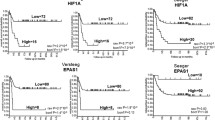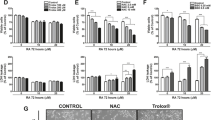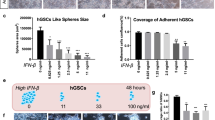Abstract
Glioblastoma is the deadliest brain tumor that remains incurable. We examined efficacy of combination of retinoid and interferon-gamma (IFN-γ) in human glioblastoma T98G and U87MG cells. We conjectured that retinoid could induce differentiation with down regulation of telomerase activity to increase sensitivity to IFN-γ for apoptosis in glioblastoma cells. Indeed, treatment of cells with 1 μM all-trans retinoic acid (ATRA) or 1 μM 13-cis retinoic acid (13-CRA) for 7 days induced astrocytic differentiation with upregulation of glial fibrillary acidic protein (GFAP) and down regulation of telomerase activity. Wright staining and ApopTag assay showed, respectively, morphological and biochemical features of apoptosis in glioblastoma cells following exposure to 200 units/ml IFN-γ for 48 h. Induction of differentiation was associated with decreases in levels of nuclear factor kappa B (NFκB), inducible nitric oxide synthase (iNOS), and production of nitric oxide (NO) so as to increase sensitivity to IFN-γ for apoptosis. Notably, IFN-γ induced signal transducer and activator of transcription-1 (STAT-1) to bind to gamma-activated sequence (GAS) of the target gene. Also, IFN-γ activated caspase-8 and cleaved Bid to truncated Bid (tBid) for translocation to mitochondria. Fura-2 assay showed increases in intracellular free [Ca2+] and activation of calpain in apoptotic cells. Besides, increases in Bax:Bcl-2 ratio and mitochondrial release of cytochrome c and Smac into the cytosol activated caspase-9 and caspase-3 for apoptosis. Taken together, our results showed that retinoid induced astrocytic differentiation with down regulation of telomerase activity and enhanced sensitivity to IFN-γ for increasing apoptosis in human glioblastoma cells.










Similar content being viewed by others
References
Rasheed BK, Wiltshire RN, Bigner SH et al (1999) Molecular pathogenesis of malignant gliomas. Curr Opin Oncol 11:162–167
Robins HI, Chang S, Butowski N et al (2007) Therapeutic advances for glioblastoma multiforme: current status and future prospects. Curr Oncol Rep 9:66–70
Todesco A, Carli M, Iacona I et al (2000) All-trans retinoic acid and interferon-alpha in the treatment of a patient with resistant metastatic osteosarcoma. Cancer 89:2661–2666
Marley SB, Davidson RJ, Goldman JM et al (2002) Effects of combinations of therapeutic agents on the proliferation of progenitor cells in chronic myeloid leukaemia. Br J Haematol 116:162–165
Veal GJ, Errington J, Redfern CP et al (2002) Influence of isomerisation on the growth inhibitory effects and cellular activity of 13-cis and all-trans retinoic acid in neuroblastoma cells. Biochem Pharmacol 63:207–215
Pendino F, Flexor M, Delhommeau F et al (2001) Retinoids down-regulate telomerase and telomere length in a pathway distinct from leukemia cell differentiation. Proc Natl Acad Sci USA 98:6662–6667
Hallum AV, Alberts DS, Lippman SM et al (1995) Phase II study of 13-cis retinoic acid plus interferon-α2a in heavily pretreated squamous carcinoma of the cervix. Gynecol Oncol 56:382–386
Thalasila A, Poplin E, Shih J et al (2003) A phase I trial of weekly paclitaxel, 13-cis retinoic acid, and interferonalpha in patients with prostate cancer and other advanced malignancies. Cancer Chemother Pharmacol 52:119–124
Vaishampayan U, Flaherty L, Du W et al (2001) Phase II evaluation of paclitaxel, α-interferon, and cis-retinoic acid in advanced renal cell carcinoma. Cancer 92:519–523
Danforth DN, Zhu Y (2005) Conversion of Fas-resistant to Fas-sensitive MCF-7 breast cancer cells by the synergistic interaction of interferon-gamma and all-trans retinoic acid. Breast Cancer Res Treat 94:81–91
Kalvakolanu DV (2004) The GRIMs: a new interface between cell death regulation and interferon/retinoid induced growth suppression. Cytokine Growth Factor Rev 15:169–194
Das A, Banik NL, Ray SK (2007) Differentiation decreased telomerase activity in rat glioblastoma C6 cells and increased sensitivity to IFN-γ and taxol for apoptosis. Neurochem Res 32:2167–2183
Das A, Banik NL, Ray SK (2006) Mechanism of apoptosis with the involvement of proteolytic activities of calpain and caspases in human malignant neuroblastoma SH-SY5Y cells exposed to flavonoids. Int J Cancer 119:2575–2585
Das A, Garner DP, Del Re AM et al (2006) Calpeptin provides functional neuroprotection to rat retinal ganglion cells following Ca2+ influx. Brain Res 1084:146–157
Repa JJ, Hanson KK, Clagett-Dame M (1993) All-trans retinol is a ligand for the retinoic acid receptors. Proc Natl Acad Sci USA 90:7293–7297
Kominsky S, Johnson HM, Bryan G et al (1998) IFN-γ inhibition of cell growth in glioblastomas correlates with increased levels of the cyclin dependent kinase inhibitor p21WAF1/CIP1. Oncogene 17:2973–2979
Tada M, Diserens AC, Desbaillets I et al (1994) Analysis of cytokine receptor messenger RNA expression in human glioblastoma cells and normal astrocytes by reverse-transcription polymerase chain reaction. J Neurosurg 80:1063–1073
Knupfer MM, Poppenborg H, Van Gool S et al (1997) Interferon-gamma inhibits proliferation and adhesion of T98G human malignant glioma cells in vitro. Klin Padiatr 209:271–274
Ray SK, Wilford GG, Crosby CV et al (1999) Diverse stimuli induce calpain overexpression and apoptosis in C6 glioma cells. Brain Res 829:18–27
Chin YE, Kitagawa M, Su WC et al (1996) Cell growth arrest and induction of cyclin-dependent kinase inhibitor p21 WAF1/CIP1 mediated by STAT1. Science 272:719–722
Kim NW, Piatyszek MA, Prowse KR et al (1994) Specific association of human telomerase activity with immortal cells and cancer. Science 66:2011–2015
Kang D, Nishida J, Iyama A et al (1995) Intracellular localization of 8-oxo-dGTPase in human cells, with special reference to the role of the enzyme in mitochondria. J Biol Chem 270:14659–14665
Nudson WA, Rovnak J, Buechner M et al (2003) Walleye dermal sarcoma virus Orf C is targeted to the mitochondria. J Gen Virol 84:375–381
Davidge ST, Baker PN, Laughlin MK et al (1995) Nitric oxide produced by endothelial cells increases production of eicosanoids through activation of prostaglandin H synthase. Circ Res 77:274–283
Ray SK, Patel SJ, Welsh CT et al (2002) Molecular evidence of apoptotic death in malignant brain tumors including glioblastoma multiforme: upregulation of calpain and caspase-3. J Neurosci Res 69:197–206
Pilkington GJ, Lantos PL (1982) The role of glutamine synthetase in the diagnosis of cerebral tumours. Neuropathol Appl Neurobiol 8:227–236
Piskurich JF, Linhoff MW, Wang Y et al (1999) Two distinct gamma interferon-inducible promoters of the major histocompatibility complex class II transactivator gene are differentially regulated by STAT-1, interferon regulatory factor 1, and transforming growth factor-β. Mol Cell Biol 19:431–440
Zhang WH, Wang X, Narayanan M et al (2003) Fundamental role of the Rip2/caspase-1 pathway in hypoxia and ischemia-induced neuronal cell death. Proc Natl Acad Sci USA 100:16012–16017
Krammer PH (2000) CD95’s deadly mission in the immune system. Nature 407:789–795
Desagher S, Osen-Sand A, Nichols A et al (1999) Bid-induced conformational change of Bax is responsible for mitochondrial cytochrome c release during apoptosis. J Cell Biol 144:891–901
Kominsky DJ, Bickel RJ, Tyler KL (2002) Reovirus-induced apoptosis requires mitochondrial release of Smac/Dablo and involves reduction of cellular inhibitor of apoptosis protein levels. J Virol 76:11414–11424
Wang KK, Posmantur R, Nadimpalli R et al (1998) Caspase-mediated fragmentation of calpain inhibitor inhibitor protein calpastatin during apoptosis. Arch Biochem Biophys 356:187–196
Sakahira H, Enari M, Nagata S (1998) Cleavage of CAD inhibitor in CAD activation and DNA degradation during apoptosis. Nature 391:96–99
Rutka JT, Hubbard SL, Fukuyama K et al (1994) Effects of antisense glial fibrillary acidic protein complementary DNA on the growth, invasion, and adhesion of human astrocytoma cells. Cancer Res 54:3267–3272
Deshpande RV, Goust JM, Chakrabarti AK et al (1995) Calpain expression in lymphoid cells. Increased mRNA and protein levels after cell activation. J Biol Chem 270:2497–2505
Scarlett JL, Sheard PW, Hughes G et al (2000) Changes in mitochondrial membrane potential during staurosporine-induced apoptosis in Jurkat cells. FEBS Lett 475:267–272
Adams JM, Cory S (2001) Life-or-death decisions by the Bcl-2 protein family. Trends Biochem Sci 26:61–66
Acknowledgments
This investigation was supported in part by the R01 grants (CA-91460 and NS-57811) from the National Institutes of Health (Bethesda, MD, USA).
Author information
Authors and Affiliations
Corresponding author
Additional information
Special issue article in honor of Dr. George DeVries.
Rights and permissions
About this article
Cite this article
Das, A., Banik, N.L. & Ray, S.K. Molecular Mechanisms of the Combination of Retinoid and Interferon-gamma for Inducing Differentiation and Increasing Apoptosis in Human Glioblastoma T98G and U87MG Cells. Neurochem Res 34, 87–101 (2009). https://doi.org/10.1007/s11064-008-9669-x
Received:
Accepted:
Published:
Issue Date:
DOI: https://doi.org/10.1007/s11064-008-9669-x




